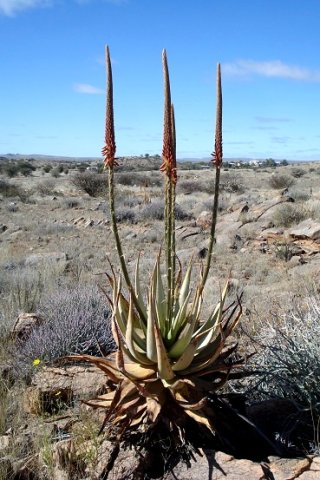Aloe gariepensis

Author: Ivan Lätti
Photographer: Judd Kirkel Welwitch
In flower Aloe gariepensis can be an imposing presence in the usually bleak, exposed, short scrub of its environment. The plants grow from smallish, solitary, stemless leaf rosettes up to larger ones on straight, erect stems of about 1 m long. Groups of branched rosettes are sometimes seen. The specimen in picture has a short stem covered in desiccated foliage, typical of mature plants of the species.
Up to five simple, unbranched inflorescences may arise simultaneously in one flowering season from a rosette in its prime. Looking carefully, it appears as if this plant has done just that. A raceme may stand up to 1,2 m tall. Buds point upwards, sagging to horizontal positions around the time when they open and further down when they are pollinated. This brings about a slightly wider mid-section to the raceme that is characteristically very straight, tall and thin.
Open perianths of red flowering specimens of A. gariepensis usually turn yellow, rendering the raceme bicoloured. Yellow to greenish yellow is the common colour for this Aloe. This plant does not seem to comply, or maybe it is too early to see and still to happen.
The species distribution is in the far north of the Northern Cape in the Richtersveld, the lower reaches of the Gariep River as far inland as Keimoes. It grows on both sides of the River, i.e. also in the southwest of Namibia.
The habitat is scrubland and desert where the plants are found in rock crevices and on steep slopes. In spite of popularity with gardeners, population numbers of A. gariepensis in the veld are not causing concern early in the 21st century. Perhaps Aloe aficionados are learning that this is not one of the species that flourishes in captivity (Frandsen, 2017; Van Wyk and Smith, 2003; Reynolds, 1974; Jeppe, 1969; iNaturalist; http://redlist.sanbi.org).

